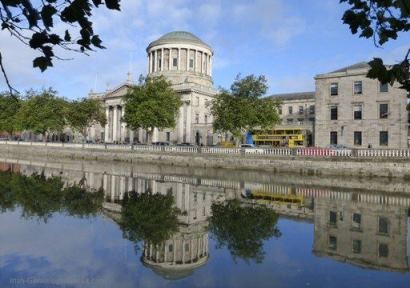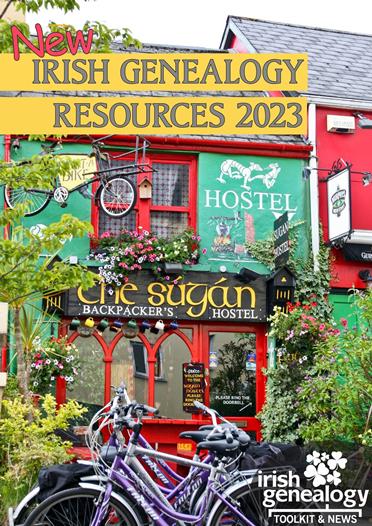- Home ›
- Irish census records ›
- The 1922 Fire
'All Irish genealogical records were destroyed in the 1922 fire': Myth or fact?
What is it that makes Irish family history research so challenging?
What is it that makes Irish family history research so challenging?
Located on the north bank of the River Liffey, Dublin's Four Courts building opened in 1802 and originally held the four courts of Chancery, King's Bench, Exchequer and Common Pleas.
 The Public Records Office was within the Four Courts building in Dublin
The Public Records Office was within the Four Courts building in Dublin The Public Records Office was within the Four Courts buildings complex beside the River Liffey, Dublin.
The Public Records Office was within the Four Courts buildings complex beside the River Liffey, Dublin.By the early 20th century, the four courts had been replaced but the name of the building retained; its west wing was being used as the Public Records Office (PRO). The PRO housed many of Ireland's genealogical treasures including census returns, originals wills dating to the 16th century, and thousands of Church of Ireland baptism, marriage and burial registers.
Sadly, nearly all were lost during the Irish Civil War on 30 June 1922 when, after a two-day bombardment, an explosion and fire ravaged the building.
As well as destroying many irreplaceable genealogical records in the Public Records Office, the interior of the Four Courts was damaged and the central dome collapsed.
The buildings have since been restored and the Four Courts sits on the River Liffey as one of the architectural gems of Dublin.
The famous fire
You will hear and read much about this fire at the PRO in the course of your genealogy research.
Too often, it is mentioned alongside a claim that 'ALL' Ireland's records were lost and, as a result, 'tracing your Irish ancestors is an impossibility'. (I wish I had a Euro for every time I've encountered this tale – I’d be exceedingly rich!) It simply isn't true.
Of course it was a catastrophic event. There is no denying that. But while the loss of so many valuable records certainly makes Irish family history challenging, the term 'impossible' is completely misleading. Some important records were nowhere near the flames.
What survived
What was lost?
Apart from a few fragments, the Irish Censuses of 1821, 1831, 1841, and 1851 were burned in the Public Records Office.
So, too, were just over half of all the Anglican Church of Ireland registers deposited there following the dis-establishment of the state church in 1869.
In addition, the majority of wills and testamentary records that had been proved in Ireland were reduced to ashes (although transcripts of many testamentary records survive).
All pre-1900 documents from the legal courts were lost, as were local government records for the same period.
Here's a quick run-through of the main record collections used by Irish genealogy researchers that either survived the fire or were nowhere near the flames .....
- The 1901 and 1911 Irish census returns survive.
- So do all civil registration records.
- So do nearly half of all Church of Ireland parish registers (many clergymen had simply not sent their registers to Dublin).
- Baptism, marriage and burial records for Roman Catholics, Presbyterians and Methodists were not housed at the Public Records Office
- Griffiths Valuation – the primary source of land and property records for the middle of the 19th century is intact.
- Indexes to wills and probate bonds survive.
- So do a good number of local muster rolls, poll tax lists and other records dating back to the very early 1600s.
..... I could go on!
What was lost?
Apart from a few fragments, the Irish Censuses of 1821, 1831, 1841, and 1851 were burned in the Public Records Office.
So, too, were just over half of all the Anglican Church of Ireland registers deposited there following the dis-establishment of the state church in 1869.
In addition, the majority of wills and testamentary records that had been proved in Ireland were reduced to ashes (although transcripts of many testamentary records survive).
All pre-1900 documents from the legal courts were lost, as were local government records for the same period.
So where does this leave you?
If you've read through the above, you'll know that a big chunk of early Irish genealogical records was lost in the 1922 fire at the Public Records Office. You'll also know that plenty of family history records survive, and most people – most – can bridge the lost 19th-century censuses to discover at least something about their ancestors in Ireland if they have a reasonable idea of where they lived.
Those hit hardest by the destruction of the PRO are those researchers descended from Church of Ireland families (never more than 25% of the island's population) and those whose ancestors were wealthy enough to make wills (again, a relatively small proportion).
I can't promise that Irish family history outside of these groups is easy peasy. Never mind 'THE 1922 FIRE THAT BURNED ALL THE RECORDS', there are even more record collections that don't survive in their entirety for completely different reasons! But depending on where (in time, as much as in place) your research starts, you have a fair chance of uncovering some part of your Irish heritage.
Where next?
- Find out how to Start your Irish family history research
- Next steps in your genealogy search: Get to know the different types of records
- More about the surviving 19th- and 20th-century Irish census
- You might also like to view a short 1925 film of the Four Courts in flames and the restoration work that followed.
This page last updated 21 January 2025



